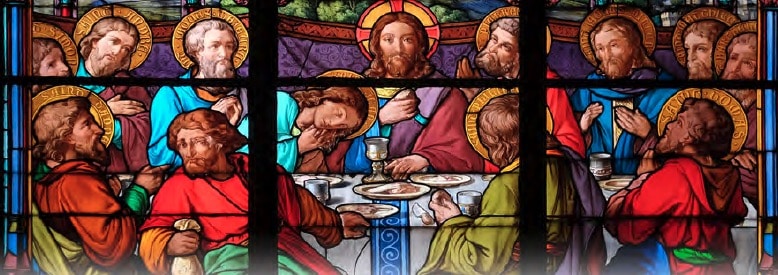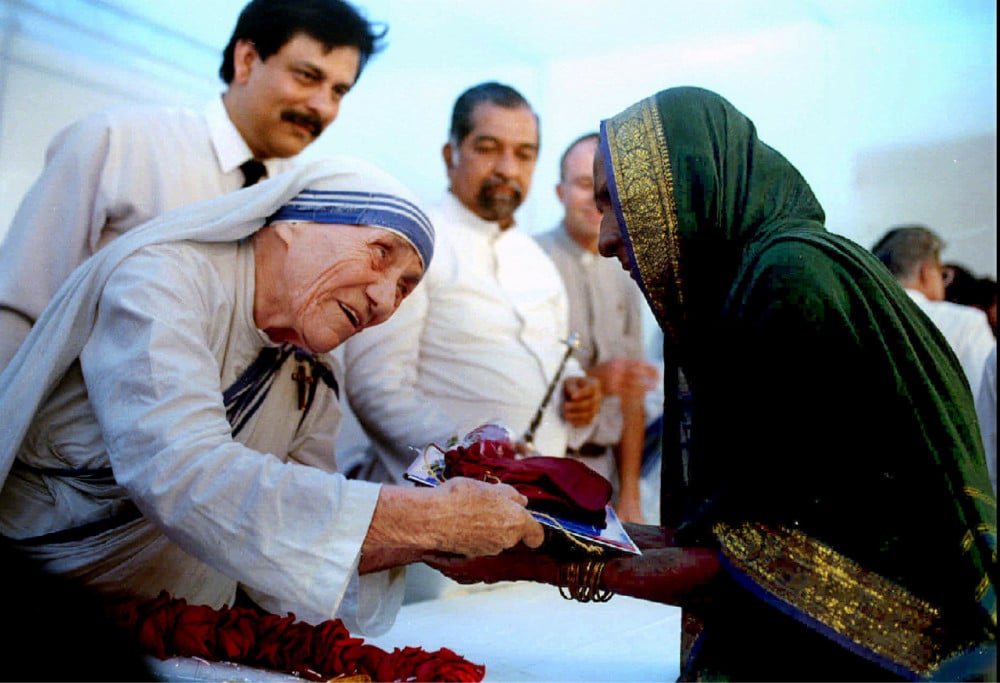Most Catholic Christians go through life seeking the one who is hidden from us. We are like someone entering a dark room and fumbling for the light switch. We want and need the light, just like we want and we need God. Jesus and his Church provides us with ways to find that Light. Among the most prominent are the sacraments — seven visible signs, sources of grace, given to us by the one we cannot see. They are part of a Catholic’s life from birth to death.
“Sacraments,” according to the Catechism of the Catholic Church, “are efficacious signs of grace instituted by Christ and entrusted to the Catholic Church by which divine grace is dispensed to us” (No. 1131) Efficacious meaning, effective, prevalent, believable. Another definition, often heard in an RCIA (OCIA) session: “a visible sign of an invisible grace.” An example is when we see two family members exchange a hug, we can see the embrace and know that love is present but we can’t see it. The hug is the visible sign and the love is the invisible yet believable result.
These are the sacraments given to the Catholic Church by Jesus: baptism, confirmation, the Eucharist, penance, anointing of the sick, holy orders and matrimony. Evolving over the centuries, seven was not always the number of sacraments; at different times, there were as few as two and as many as 30. There were periods when rituals concerning the feet washing ceremony, candles, holy water, sign of the cross and others that had sacraments linked to them. At the 16th-century Council of Trent, the bishops affirmed the seven sacraments we have today and made them an article of faith: “If anyone says that the sacraments of the New Law were not instituted by Jesus Christ, Our Lord, or that these are more or less than seven, namely, baptism, confirmation, Eucharist, penance, extreme unction, order and matrimony or that anyone of these seven is not truly and strictly speaking a sacrament-let him be anathema” (Canon 1, Session VII). Clearly, we believe that the sacraments have their origin in Jesus, and that he proclaims them through the Church. Three of these sacraments are never repeated: baptism, confirmation and holy orders; they impart an indelible seal on the soul of the recipient.
Non-Catholics often ask, “Where are the sacraments named in the Bible?” Their thinking is that the Ten Commandments are clearly listed, as are the beatitudes, but where is a list of sacraments? There is no such list, but the seven sacraments of the Catholic Church are clearly established in sacred Scriptures.
Sacrament of Baptism
 The early baptisms were administered by the apostles, first to the Jews and later to the gentiles. The apostles were called by Christ to, “Go into the whole world and proclaim the Gospel to every creature. Whoever believes and is baptized will be saved; whoever does not believe will be condemned” (Mk 16:15-16). The apostles brought the Gospel message to people who likely never heard of Jesus. Sometimes their visits to cities and towns were brief, sometimes they stayed for years. When possible, the apostles preached in the synagogue; they witnessed Christ crucified, Christ resurrected, the words they heard him say, the actions they saw him take.
The early baptisms were administered by the apostles, first to the Jews and later to the gentiles. The apostles were called by Christ to, “Go into the whole world and proclaim the Gospel to every creature. Whoever believes and is baptized will be saved; whoever does not believe will be condemned” (Mk 16:15-16). The apostles brought the Gospel message to people who likely never heard of Jesus. Sometimes their visits to cities and towns were brief, sometimes they stayed for years. When possible, the apostles preached in the synagogue; they witnessed Christ crucified, Christ resurrected, the words they heard him say, the actions they saw him take.
Preaching by the apostles was not limited to the synagogue. Lydia, a dealer in purple cloth, heard Paul speak along a river bank (cf. Acts 16:13-15). The Philippi jailer was converted in a jail (cf. Acts 16:25-34). Cornelius, the Roman centurion, listened to Peter in the centurion’s home (cf. Acts 10:44-49). Deacon Phillip explained the sacred Scriptures to the Ethiopian eunuch along the road between Gaza and Jerusalem (cf. Acts 8:26-40). According to the Scriptures, these individuals, and in most cases all their families including children, were baptized during the referenced encounters. The same Scriptures describe the Holy Spirit as being present at each of these baptisms, all of which can be traced to the example of Jesus’ baptism (cf. Mt 3:3-17). His baptism by John the Baptist foreshadows every other baptism and established baptism as a sacrament.

John the Baptist prophesied the need to repent and be baptized because the Messiah was coming. His baptism forgave sins, a baptism of repentance; it did not confer grace but prepared people for the one they had long been waiting for. John told all who would listen that he baptized with water while Jesus would baptize with the Holy Spirit. In Matthew (3:15-16), Jesus approached John for baptism. Our Divine Savior had no need of baptism, but he associated himself with sinners in this manner because it was God’s plan for him and for the salvation of mankind. So, on a river bank, in the presence of the Father and the Holy Spirit, Jesus was baptized. Through that action, Jesus sanctified and instituted the Sacrament of Baptism. He later defined the need for baptism to Nicodemus: “Amen, Amen, I say to you, no one can enter the kingdom of God without being born of water and Spirit” (Jn 3:5). Baptism opens the door to all the other sacraments and, along with Confirmation and Eucharist, is among the Sacraments of Initiation.
Sacrament of Confirmation
 Pope Miltiades (r. 311-14) wrote: “In baptism man is enlisted into the service, in confirmation he is equipped for battle.” Confirmation was not a standard ritual in the early Church but emerged as such over the first few centuries. None of the baptisms referenced in the previous paragraph specifically included a confirmation ceremony (as we know it). There are scriptural examples indicating that following a baptism, the apostles laid hands on those baptized. This act of laying on of hands is found in both the Old and New Testaments and was part of blessings, healings and instilling the Holy Spirit. With few exceptions, instilling the Holy Spirit (or confirmation) was not a ceremony meant to be separate from baptism during the apostolic era. Bishops, as successors to the apostles, assumed the role of laying on of hands, anointing with holy oil immediately following a baptism. Priests could baptize but only a bishop could perform the sacrament of confirmation. Eventually the number of converts, combined with the limited number of bishops, created delays in confirmation for the newly baptized and, accordingly, the sacraments were often celebrated at different times.
Pope Miltiades (r. 311-14) wrote: “In baptism man is enlisted into the service, in confirmation he is equipped for battle.” Confirmation was not a standard ritual in the early Church but emerged as such over the first few centuries. None of the baptisms referenced in the previous paragraph specifically included a confirmation ceremony (as we know it). There are scriptural examples indicating that following a baptism, the apostles laid hands on those baptized. This act of laying on of hands is found in both the Old and New Testaments and was part of blessings, healings and instilling the Holy Spirit. With few exceptions, instilling the Holy Spirit (or confirmation) was not a ceremony meant to be separate from baptism during the apostolic era. Bishops, as successors to the apostles, assumed the role of laying on of hands, anointing with holy oil immediately following a baptism. Priests could baptize but only a bishop could perform the sacrament of confirmation. Eventually the number of converts, combined with the limited number of bishops, created delays in confirmation for the newly baptized and, accordingly, the sacraments were often celebrated at different times.

The Acts of the Apostles details that Jesus, through the apostles, established confirmation as a sacrament. After receiving the gift of the Spirit at Pentecost, the apostles went down to Samaria to preach to those who had chosen to follow Our Lord Jesus. Peter and John arrived and “prayed for them, that they might receive the holy Spirit, for it had not yet fallen upon any of them. … Then they laid hands on them and they received the holy Spirit” (Acts 8:14-17). We read in Acts (19:1-7) about Paul laying hands on people in Ephesus who had been baptized with the baptism of John. Learning that they knew nothing of the Holy Spirit, he baptized them in the name of Jesus and then instilled them with the Holy Spirit: “And when Paul laid [his] hands on them, the holy Spirit came upon them, and they spoke in tongues and prophesied.”
When the Holy Spirit descended on those gathered in the Upper Room at Pentecost (cf. Acts 2), the apostles, who had been hesitant, fearful, even cowardly, suddenly became undaunted witnesses to Jesus. Such is the case during every Sacrament of Confirmation; the one receiving the Holy Spirit, receiving the laying on of hands and the holy oil, are bestowed with the same courage given the apostles — that is, those confirmed become soldiers of Christ and are meant to share their good news.
Sacrament of the Eucharist
 At the Last Supper, Jesus instituted the Most Holy Eucharist as a sacrament, which we celebrate at every Mass. It is not a token or symbol but was identified by Jesus as his body at the Last Supper: he gave the apostles the bread that he had blessed, saying, “Take and eat: This is my body. … This is my blood.” Each of the synoptic gospels have similar words, and the meaning is clear. He didn’t say, “Here is my body, here is my blood”; he didn’t say, “this is the symbol of my body and blood.” Also, in John chapter 6, Jesus said that he is the bread of life, the bread from heaven and, “unless you eat the flesh of the Son of Man and drink his blood, you do not have life within you” (Jn 6:53). There is nothing ambiguous in anything he is saying. “Since Christ himself has said: ‘This is my Body’ — who shall dare to doubt that It is his Body,” said St. Cyril of Jerusalem. He who fed the five thousand with five barley loaves and two fish, now feeds millions, throughout all generations, with his Body and Blood. Christ, through the Most Holy Eucharist, remains with us forever.
At the Last Supper, Jesus instituted the Most Holy Eucharist as a sacrament, which we celebrate at every Mass. It is not a token or symbol but was identified by Jesus as his body at the Last Supper: he gave the apostles the bread that he had blessed, saying, “Take and eat: This is my body. … This is my blood.” Each of the synoptic gospels have similar words, and the meaning is clear. He didn’t say, “Here is my body, here is my blood”; he didn’t say, “this is the symbol of my body and blood.” Also, in John chapter 6, Jesus said that he is the bread of life, the bread from heaven and, “unless you eat the flesh of the Son of Man and drink his blood, you do not have life within you” (Jn 6:53). There is nothing ambiguous in anything he is saying. “Since Christ himself has said: ‘This is my Body’ — who shall dare to doubt that It is his Body,” said St. Cyril of Jerusalem. He who fed the five thousand with five barley loaves and two fish, now feeds millions, throughout all generations, with his Body and Blood. Christ, through the Most Holy Eucharist, remains with us forever.
St. Justin Martyr (100-165) provides an example of how the Eucharist was received by those newly baptized in the second century: “After we have washed someone who has been convinced and has accepted our teaching, we bring him to the place where those who are called ‘brethren’ are assembled, [probably someone’s home].” They all prayed together, and the president of the brethren received the bread and the wine. “Taking them, he gives praise and glory to the Father of the universe, through the name of the Son and of the Holy Spirit, and he offers thanks at a considerable length that we have been counted worthy to receive these things from his hands. … And when the president has given thanks, and all the people have expressed their assent, those who we call deacons distribute to each of those present a portion of the bread and wine mixed with water, over which the thanksgiving was pronounced” (First Apology, No. 65). Once churches were built, and assuming the bishop was available, those baptized would be brought inside the Church, receive the laying on of hands, anointed and then participated in the Liturgy of the Eucharist. A newly baptized infant was given a few drops of the precious blood.
Sacrament of Marriage
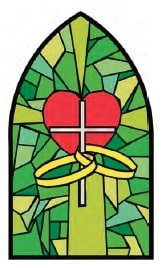 Marriage between two baptized Christians is an irrevocable and inviolable contract. The only way it can be terminated while both spouses live is if there is proof that the marriage was not legal to begin with, not legal in the eyes of the Church. Matrimony involves a baptized man and a baptized woman both of whom consent to being joined in marriage. The man and the woman are equals in the sight of God. Before Christ came, women were treated differently than men, in many cases, treated as property but because of Christ all the baptized are equal. Jesus spells out the permanency of marriage in the Gospel of Matthew (19:1-12).
Marriage between two baptized Christians is an irrevocable and inviolable contract. The only way it can be terminated while both spouses live is if there is proof that the marriage was not legal to begin with, not legal in the eyes of the Church. Matrimony involves a baptized man and a baptized woman both of whom consent to being joined in marriage. The man and the woman are equals in the sight of God. Before Christ came, women were treated differently than men, in many cases, treated as property but because of Christ all the baptized are equal. Jesus spells out the permanency of marriage in the Gospel of Matthew (19:1-12).
The purpose of marriage is the procreation of children and bringing them up in the Church as well as the husband and wife mutually helping each other attain eternal life — heaven. God is at the center of every marriage, and his relationship with man and woman is identified in the scriptures, found first in Genesis: “The Lord God said: It is not good for man to be alone” (2:18). Then Scripture tells us, from man’s rib he created woman (cf. 2:22). Here in the garden of Eden, God proclaimed and blessed the marriage of Adam and Eve, the first marriage. “That is why a man leaves his father and mother and clings to his wife, and the two of them become one body” (2:24).
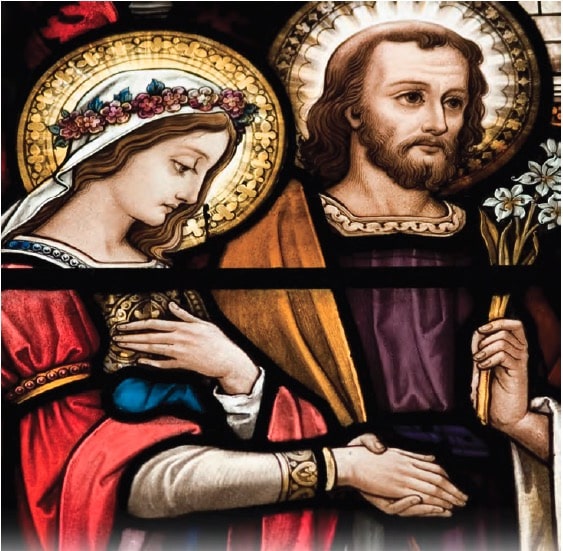 In St. Paul’s letter to the Ephesians, the saint relates the bond of marriage to the bond between Jesus and the Church, a bond that will last forever. St. Paul repeats the words found in Genesis 2, “For this reason a man shall leave [his] father and [his] mother and be joined to his wife, and the two shall become one flesh” (5:31). Paul adds “This is a great mystery, but I speak in reference to Christ and the church” (5:32). The Latin term for mystery is sacramentum. Matrimony, the love of a man and woman, is symbolic of the love God has for mankind, “For God himself is the author of matrimony” (Gaudium et spes, “The Church in the Modern World,” No. 48)
In St. Paul’s letter to the Ephesians, the saint relates the bond of marriage to the bond between Jesus and the Church, a bond that will last forever. St. Paul repeats the words found in Genesis 2, “For this reason a man shall leave [his] father and [his] mother and be joined to his wife, and the two shall become one flesh” (5:31). Paul adds “This is a great mystery, but I speak in reference to Christ and the church” (5:32). The Latin term for mystery is sacramentum. Matrimony, the love of a man and woman, is symbolic of the love God has for mankind, “For God himself is the author of matrimony” (Gaudium et spes, “The Church in the Modern World,” No. 48)
The first miracle performed by Jesus took place at a wedding, the Wedding at Cana (cf. Jn 2:1-11). That marriage was blessed and graced by the presence of Our Lord. In the same manner, Jesus, through the priest, is present at every wedding. His being at Cana was not by chance; his presence, the miracle he performed, signals the act of marriage as being unique in the eyes and hands of God. It is a sacrament.
As stated by the Council of Trent: “If anyone says that Matrimony is not truly and properly one of the seven sacraments of the New Law, instituted by Christ our Lord, but was invented by men in the Church and does not confer grace, let him be anathema” (Canon 1, Session 24).
Sacrament of Holy Orders
 The Church would not exist save for Jesus instituting the Sacrament of Holy Orders, the priesthood. We would be without the Eucharist and the forgiveness of sin; marriages would not be blessed, no solace at life’s end. In sum, without Holy Orders, we could not receive the sacraments. Holy Orders was clearly manifested as a sacrament beginning at the Last Supper, when Jesus gave the apostles the consecrated bread and wine, saying to them, “Do this in memory of me” (Lk 22:19). Twenty-five years later, St. Paul in his first letter to the Corinthians (11:23-25), reminds his readers that Jesus instituted the Eucharist and Holy Orders at the Last Supper: “For I received from the Lord what I also handed on to you, that the Lord Jesus on the night he was handed over, took bread, and after he had given thanks, broke it and said, ‘This is my Body that is for you. Do this in remembrance of me.’ In the same way also the cup, after supper, saying, ‘This cup is of the new covenant in my blood. Do this, as often as you drink it, in remembrance of me.'” At the Last Supper, Christ instructed his apostles, and the priests who come after them, to act on his behalf, to continue offering the Eucharist until he returns.
The Church would not exist save for Jesus instituting the Sacrament of Holy Orders, the priesthood. We would be without the Eucharist and the forgiveness of sin; marriages would not be blessed, no solace at life’s end. In sum, without Holy Orders, we could not receive the sacraments. Holy Orders was clearly manifested as a sacrament beginning at the Last Supper, when Jesus gave the apostles the consecrated bread and wine, saying to them, “Do this in memory of me” (Lk 22:19). Twenty-five years later, St. Paul in his first letter to the Corinthians (11:23-25), reminds his readers that Jesus instituted the Eucharist and Holy Orders at the Last Supper: “For I received from the Lord what I also handed on to you, that the Lord Jesus on the night he was handed over, took bread, and after he had given thanks, broke it and said, ‘This is my Body that is for you. Do this in remembrance of me.’ In the same way also the cup, after supper, saying, ‘This cup is of the new covenant in my blood. Do this, as often as you drink it, in remembrance of me.'” At the Last Supper, Christ instructed his apostles, and the priests who come after them, to act on his behalf, to continue offering the Eucharist until he returns.
 During the ordination ceremony, the divine grace of God is conferred, through the imposition of hands and holy oil, on men selected as bishops, priests and deacons. Graced by God, these men live out their lives in service to God and the Church. As stated in the Catechism, “Catholic doctrine teaches that the degrees of priestly participation (episcopate and presbyterate) and the degree of service (diaconate) are all three conferred by a sacramental act called ‘ordination,’ that is, by the sacrament of Holy Orders” (CCC, No. 1554).
During the ordination ceremony, the divine grace of God is conferred, through the imposition of hands and holy oil, on men selected as bishops, priests and deacons. Graced by God, these men live out their lives in service to God and the Church. As stated in the Catechism, “Catholic doctrine teaches that the degrees of priestly participation (episcopate and presbyterate) and the degree of service (diaconate) are all three conferred by a sacramental act called ‘ordination,’ that is, by the sacrament of Holy Orders” (CCC, No. 1554).
One of the first scriptural references to ordinations is found in Acts (6:1-7). The apostles said they were in need of others to distribute alms: “Brothers, select from among you seven reputable men, filled with the Spirit and wisdom, whom we shall appoint to this task.” These were the first deacons in the Church. They were presented to the apostles “who prayed and laid hands on them.”
The Council of Trent said: “Whereas, by the testimony of Scripture, by Apostolic tradition and the unanimous consent of the Fathers, it is clear that grace is conferred by sacred ordination, which is performed by words and outward signs, no one ought to doubt that Order is truly and really one of the seven sacraments of the holy Church” (Session 23, Chapter III).
Sacrament of the Anointing of the Sick
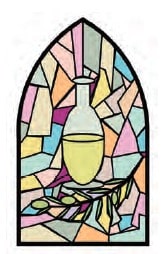 For centuries the Sacrament of Anointing of the Sick was known as Extreme Unction, an anointing given to those near death. In 1972 the Church expanded the sacrament so it can be given to aging people, the sick, someone undergoing serious surgery and also a person near death. It can be received more than once. The objective has always been to offer those receiving the sacrament the divine assistance and courage to deal with their particular situation. Persons at the end of life are also given holy Communion, known as viaticum or “food for the journey.” If the individual is near death and conscious, he or she is offered to make their confession, make their penance, receive the Eucharist and are then anointed. The efficacy of the sacrament, as with all the sacraments, depends on the disposition of the recipient. The unconscious individual can also be anointed and, by the divine grace of God, their sins are forgiven.
For centuries the Sacrament of Anointing of the Sick was known as Extreme Unction, an anointing given to those near death. In 1972 the Church expanded the sacrament so it can be given to aging people, the sick, someone undergoing serious surgery and also a person near death. It can be received more than once. The objective has always been to offer those receiving the sacrament the divine assistance and courage to deal with their particular situation. Persons at the end of life are also given holy Communion, known as viaticum or “food for the journey.” If the individual is near death and conscious, he or she is offered to make their confession, make their penance, receive the Eucharist and are then anointed. The efficacy of the sacrament, as with all the sacraments, depends on the disposition of the recipient. The unconscious individual can also be anointed and, by the divine grace of God, their sins are forgiven.
In the Gospel according to Mark, Jesus sent the apostles out with “authority over unclean spirits. … They drove out many demons, and they anointed with oil many who were sick and cured them” (6:7, 13). Here then is an indication that holy oil in the hands of the apostles had special qualities that, if not to cure, are to provide encouragement to the sick. This sacrament is today administered by our priests.
That the anointing of the sick is a sacrament is clear in the book of James: “Is anyone among you suffering? He should pray. Is anyone in good spirits? He should sing praise. Is anyone among you sick? He should summon the presbyters of the church, and they should pray over him and anoint [him] with oil in the name of the Lord, and the prayer of faith will save the sick person, and the Lord will raise him up. If he has committed any sins, he will be forgiven” (Jas 5:13-15). The bishops at the Council of Trent concluded that extreme unction “was instituted by Christ our Lord as truly and properly a sacrament of the new law, insinuated indeed in Mark, but recommended and promulgated to the faithful by James the Apostle” (Session 14, Second Decree, Chapter I).
Sacrament of Confession
 This sacrament is unmistakably of divine origin. Jesus, on the night of his resurrection, said to the apostles: “Peace be with you. As the Father has sent Me, so I send you. And when he had said this, he breathed on them and said to them, ‘Receive the holy Spirit. Whose sins you forgive are forgiven them, and whose sins you retain are retained'” (Jn 20:21-23). These words establish the Sacrament of Confession. Jesus gave the power to forgive sins to his apostles and through them to the bishops and priests today. The Gospel according to Matthew, chapters 16 and 18, has a similar message.
This sacrament is unmistakably of divine origin. Jesus, on the night of his resurrection, said to the apostles: “Peace be with you. As the Father has sent Me, so I send you. And when he had said this, he breathed on them and said to them, ‘Receive the holy Spirit. Whose sins you forgive are forgiven them, and whose sins you retain are retained'” (Jn 20:21-23). These words establish the Sacrament of Confession. Jesus gave the power to forgive sins to his apostles and through them to the bishops and priests today. The Gospel according to Matthew, chapters 16 and 18, has a similar message.
Are there any more precious or desired words than those of absolution given by the priest in the confessional? As the representative of Jesus, the priest says, “I absolve you of your sins.” There is no sin the Church cannot forgive, and forgiveness awaits us in the Sacrament of Confession. Here again the effectiveness of the sacrament depends on the disposition of the person receiving it.
As is the case with the other sacraments, when we go to confession, we experience a personal encounter with Christ. An example of such an encounter and belief in the power of Christ is found when Jesus healed the woman who was hemorrhaging for 12 years, “[She] came up behind him and touched the tassel on his cloak. She said to herself, ‘If only I can touch his cloak, I shall be cured.’ Jesus turned around and saw her, and said, ‘Courage daughter! Your faith has saved you.’ And from that hour the woman was cured” (Mt 9:20-21). She had the right intention, sought out his presence and was healed.

D. D. Emmons writes from Pennsylvania.
| Baptism and confession in the early Church |
|---|
 The first Christians believed that once baptized, a person would never again sin, and thus there was little focus on confession or on reconciliation. Those individuals, until at least the fourth century, risked their lives to become Christians, to be baptized. If found out, they could be persecuted, if not killed. The first Christians believed that once baptized, a person would never again sin, and thus there was little focus on confession or on reconciliation. Those individuals, until at least the fourth century, risked their lives to become Christians, to be baptized. If found out, they could be persecuted, if not killed.
Some at the time argued that there was no forgiveness after baptism; another belief was that you could be forgiven but only once. Hermas, a second-century author, wrote: “‘I have heard sir … that there is no other penance except that which took place when we went down into the water and obtained remission of our former sins.’ He said to me, ‘You have heard rightly … one who has received remission of sins ought never to sin again but live in purity. … But I say to you … after this great and holy calling, if a man be tempted by the devil and sin, he has one repentance. But if he sin and repent repeatedly — repentance is of little value to such a man, and with difficulty will he live'” (“The Shepherd,” A.D. 140-155). |


